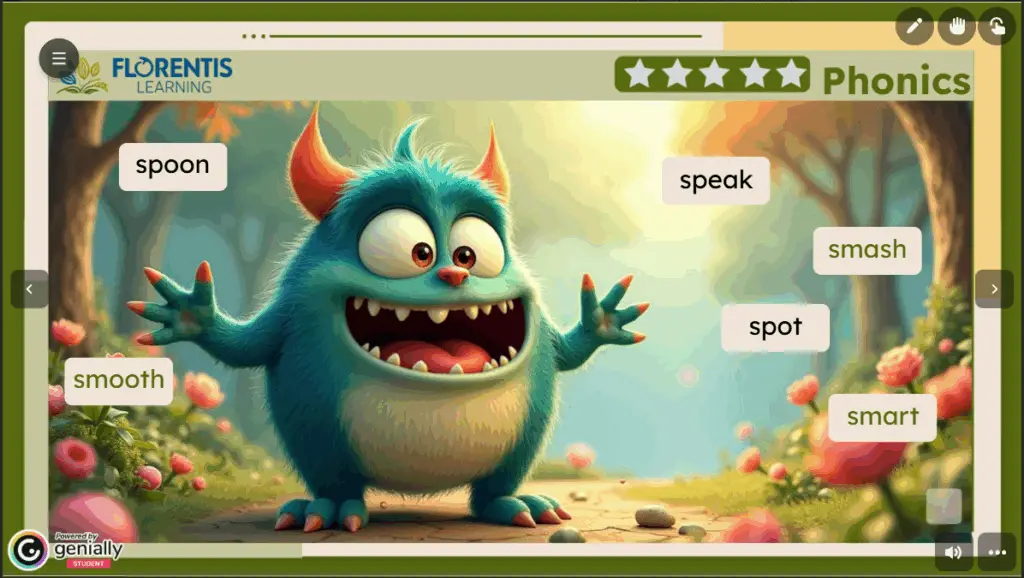Teaching phonics online can feel challenging—even for experienced ESL teachers. But with the right strategies, you can make phonics engaging, effective, and fun for students of all ages.
Whether you’re working with absolute beginners or helping more advanced learners improve reading and spelling, phonics should be part of your toolkit. This guide will walk you through why phonics matters in ESL and share five proven strategies that work beautifully in online classes.
If you’re looking for a structured, ready-to-teach approach, you’ll also see how Florentis Learning makes teaching phonics online simple and effective.
Why Phonics Matters in ESL
Phonics isn’t just for native-speaking kids in kindergarten! For ESL learners, phonics instruction helps unlock reading, writing, and confident pronunciation.
When students learn how sounds map to letters, they can:
✅ Decode new words independently
✅ Improve spelling accuracy
✅ Build reading fluency and comprehension
✅ Pronounce English words more accurately
Many ESL teachers find that even students who can speak conversationally often struggle with reading and writing. Systematic phonics instruction bridges that gap. Learn more about systematic phonics instruction such as the Science of Reading in this video from UFLI.
At Florentis Learning, we believe every student deserves this strong foundation—which is why our curriculum includes dedicated phonics instruction for beginners and emerging readers.
The Challenge of Teaching Phonics Online
If you’ve tried teaching phonics over Zoom or another platform, you know it’s different from an in-person classroom:
- It’s harder to see and correct mouth movements.
- Young learners may lose focus without physical manipulatives.
- Teachers need to be creative to keep lessons interactive.
But these challenges are solvable! The strategies below will help you turn your online phonics lessons into a highlight of your students’ week.
Strategy 1: Make It Multi-Sensory
Phonics works best when students use multiple senses—seeing, hearing, saying, writing. Online teachers can replicate these methods with clever tools:
- On-screen letter tiles: Use Google Jamboard, PowerPoint, or your online platform’s whiteboard to drag and build words. Alternatively, use a co-browser such as Koala Go which allows your student to engage in all of the interactive games and activities.
- Air-writing: Have students write letters in the air while saying the sound.
- Clapping syllables: Build phonological awareness in a physical, rhythmic way.
- Drawing letters: Use simple drawing tools or hold up paper to the camera.
Multi-sensory teaching isn’t just engaging—it’s essential for helping students retain sound-letter connections.
Florentis Learning’s Phonics Fun and Core ESL Curriculum feature multi-sensory activities like games, blending tiles, letter drawing, clapping syllables, and air writing to make phonics engaging and effective online.

Strategy 2: Teach in Small, Explicit Steps
Phonics instruction should be systematic. Avoid overwhelming students by introducing too many sounds at once.
Instead:
✅ Teach 2–3 new sounds at a time.
✅ Blend them into simple words.
✅ Practice reading and writing those words.
✅ Review regularly.
For example, start with CVC words (like cat, pen, dog), then move to blends (stop, flag) and digraphs (ch, sh).
At Florentis Learning, our phonics lessons follow this gradual, explicit progression so teachers can focus on teaching instead of planning.
Strategy 3: Use Games to Reinforce Sounds
Phonics can be playful! Online games keep students engaged and reinforce learning without feeling like drills. Here are a few easy options:
- Find the Sound: Students look for objects in their room with a target sound.
- Flashcard Races: Share screen and have students read sounds or words quickly.
- Minimal Pairs Bingo: Practice tricky sounds (e.g., ship/sheep).
- Feed the Monster: Students “feed” words with the target sound to an on-screen monster.
- Memory Matching: Use digital cards to match letters and sounds.
You can adapt these games with simple slides or online whiteboards.

Looking for even more ideas? Check out our post on Fun Online ESL Warm-Ups for additional inspiration!
Strategy 4: Integrate Reading and Spelling Practice
Phonics isn’t just about isolated sounds—it’s about applying them in real reading and writing.
In your online lessons, you can:
- Share decodable texts on screen.
- Take turns reading lines aloud.
- Use typing or handwriting for spelling practice.
- Dictate simple sentences for students to write.
These activities show students that phonics is practical. It builds reading fluency, spelling confidence, and overall literacy.
Florentis Learning’s curriculum integrates phonics with reading and writing practice in every lesson, making this easy for you to teach.

Strategy 5: Use Repetition and Routine
Finally, consistency is key. Students learn best when they know what to expect.
Consider using a simple structure for every phonics lesson:
1️⃣ Review known sounds
2️⃣ Introduce the new sound
3️⃣ Blend/read words
4️⃣ Play a game to reinforce
5️⃣ Practice spelling or sentence writing
Repetition helps students internalize new skills. It also reduces planning time for you!

Bonus Tip: Engage Parents (for Young Learners)
If you’re teaching young students, don’t forget the power of family support.
- Explain your phonics goals in simple terms to parents.
- Provide short, clear practice tasks they can help with.
- Encourage reading together at home.
This builds buy-in and ensures students get valuable practice between lessons.
If you want ideas for communicating with parents, see our post on Explaining Your Teaching Style to Parents.
How Florentis Learning Supports Online Phonics Teaching
Ready to make teaching phonics online easier than ever—and get lifetime access to all the tools you need?
Conclusion
Phonics is a cornerstone of ESL literacy, and teaching it online is absolutely doable with the right strategies.
✅ Make it multi-sensory
✅ Teach in small, explicit steps
✅ Use games to keep it fun
✅ Integrate reading and spelling
✅ Build consistent routines
With these approaches—and the support of a structured curriculum—you can help your students become confident, independent readers and writers in English.
Ready to level up your online ESL teaching? Explore the Florentis Learning Curriculum to get started today or grab the Free Sample Pack which gives you access to one of the Florentis Learning Phonics lessons so you can try it out for yourself!
What is phonics in ESL teaching?
Phonics is the method of teaching students how letters and sounds connect to help them read and spell words accurately.
Can phonics be taught effectively online?
Yes! With multi-sensory activities, games, and structured lessons, phonics can be engaging and effective in online ESL classes.
What are some online phonics activities for ESL students?
Try flashcard races, minimal pairs bingo, digital letter tiles, and interactive decodable reading for fun, effective practice.
How can I make my online phonics lessons more engaging?
Use games, visual aids, whiteboards, and consistent routines to keep learners involved and help them retain new sounds.
Does Florentis Learning include phonics lessons?
Yes! The Complete Classroom ESL Curriculum has a full phonics progression with interactive slides, games, and reading practice.



Leave a Reply